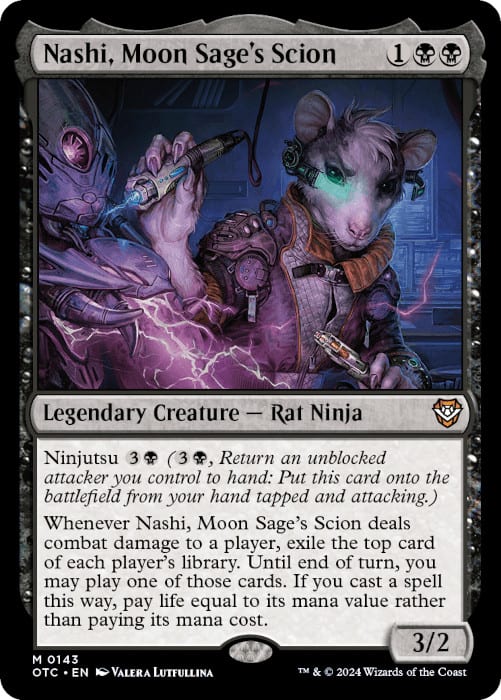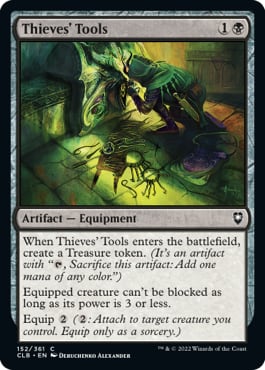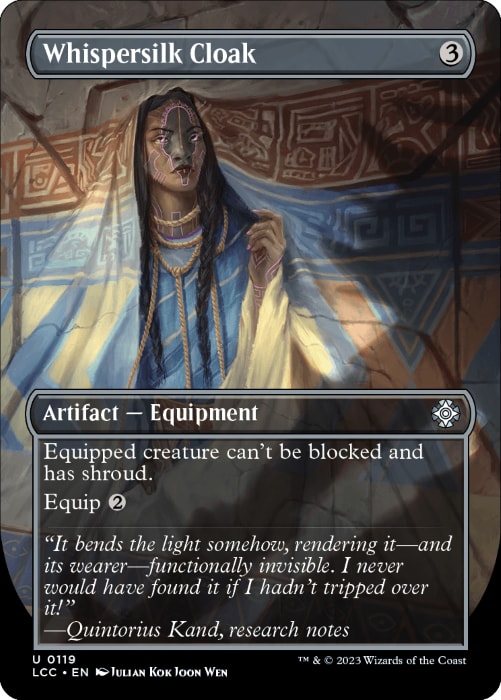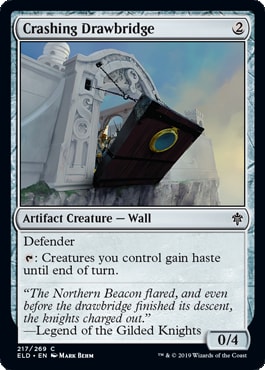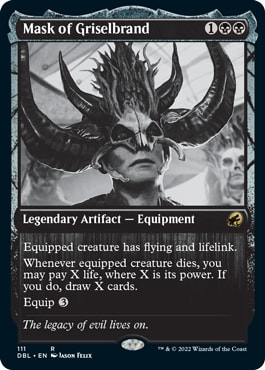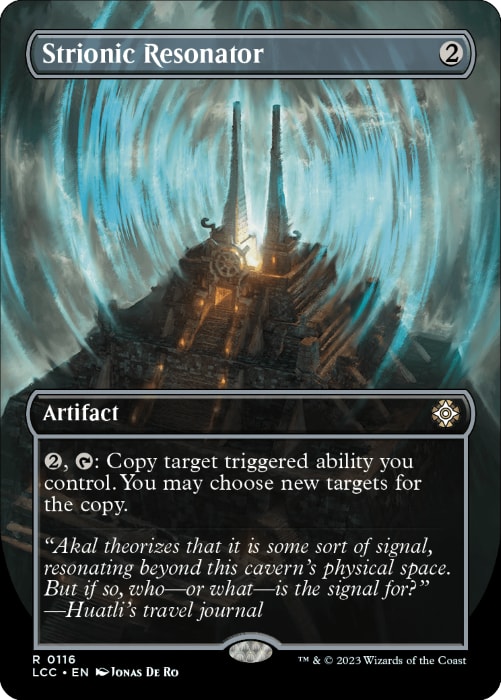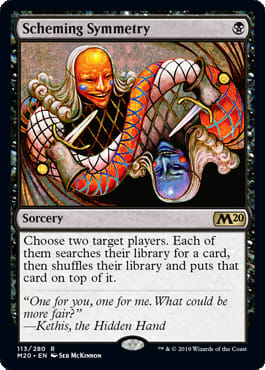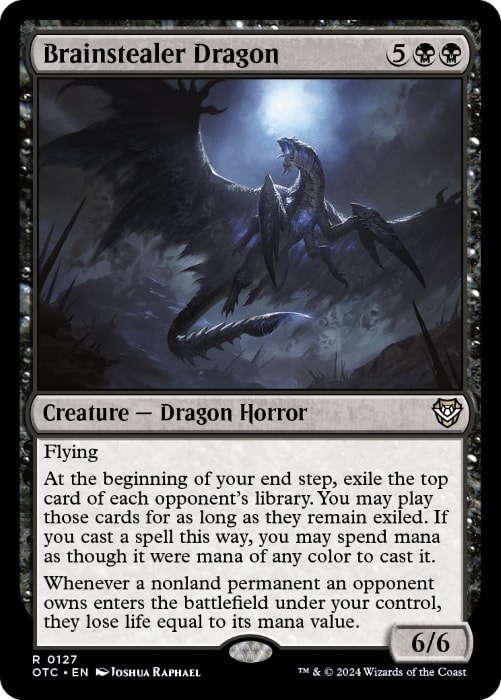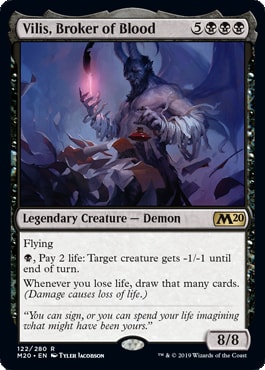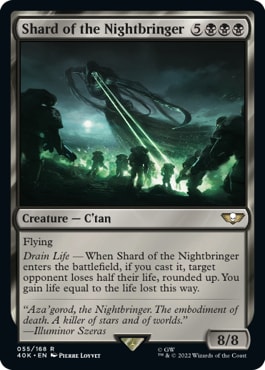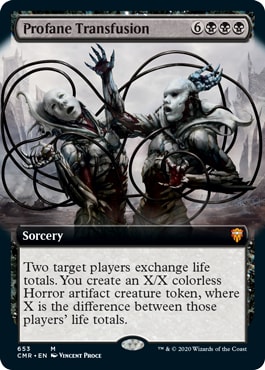I never expected Magic to return to Kamigawa. It's a setting I've always adored, as a long-time anime fan, but the constant insistence from Wizards of the Coast that it wasn't going to happen had crushed my hopes, at least until it finally happened.
While I'm personally quite fond of the original Kamigawa block, its poor reputation exists for a very good reason. I never expected Kamigawa: Neon Dynasty to take much mechanical inspiration from it. However, I still found myself a bit disappointed when I took a good look at the set and realized that as a Commander player, not many of its new legendaries excited me.
Thankfully, however, there was one exception.
Nashi, Moon Sage's Scion is a Mono-Black legendary creature with a respectable 3 power and 2 toughness for its three-mana cost. He has ninjitsu, but in the command zone that's not particularly relevant. Nashi's real strength is in his last ability. When he deals combat damage to a player you exile the top card of every player's library and can play one of the exiled cards by spending life.
When I saw this card I couldn't help but be reminded of Etali, Primal Storm. That card is a completely different color and possesses significantly more raw power in essentially every respect, but it's important to remember that Nashi costs half as much mana as Etali. You can very consistently swing with him by turn four or earlier. With commanders that can let you cheat on mana costs like this, the sooner you can get them online, the better.
Set Up
As a 3/2 with no evasion and a powerful combat damage ability, Nashi is extremely vulnerable to enemy blockers. It's important to get him on the field and turned sideways as quickly as possible, and to do whatever you can to ensure he isn't picked off by blockers or removal spells.
I'll be running several cards that make Nashi more difficult to block.
Thieves' Tools is a two-mana equipment that equips for another 2 mana, and can make a creature unblockable so long as it has 3 or less power - something our commander just so happens to have. It also gives back part of its already low mana cost in the form of a treasure token. While we can't use that treasure as a form of mana fixing in this deck, banking mana for future turns is still valuable.
Call of the Ring is a two-mana enchantment that causes the ring to tempt you at the beginning of your upkeep, and allows you to pay two life to draw a card whenever that happens. When you're tempted, you choose a ringbearer. Your ringbearer can't be blocked by creatures with greater power, and additional tempts will give it even more abilities - drawing and discarding a card when it attacks, killing any creature that blocks it, and draining your opponents for three life when it deals damage. This card does an enormous amount, and this deck benefits from all of it.
Whispersilk Cloak is a three-mana equipment with a two-mana equip cost, and it gives the equipped creature shroud and unblockable. In addition to evasion, this is an extremely valuable source of protection from removal, more than warranting its somewhat hefty cost.
Sources of haste are extremely useful in this deck, since they can let Nashi start swinging in a turn sooner. On top of the self-evidently powerful Lightning Greaves, I'm also using Crashing Drawbridge. Haste is a difficult keyword to come by in Black, and this card can double as a blocker, deterring small attacks that might otherwise pick away at your life total. Life is a crucial resource in this deck, and if you don't manage it carefully, your opponents will take advantage of your lower life total.
Mask of Griselbrand is a perfect way to keep that from happening. It's a three-mana equipment with a three-mana equip cost, and it gives the equipped creature flying and lifelink. Flying is an often underrated form of evasion. Gaining 3 life a turn from combat damage may not sound like a lot, but you'll be spending more life on casting spells exiled by Nashi than you'll gain from lifelink. Mask of Griselbrand will also let you pay life to draw cards when the equipped creature dies, which can help keep you afloat if Nashi does die to removal, a board clear, or an unexpected flier.
With Nashi's combat damage ability being as strong as it is, it only makes sense to double down on it. Strionic Resonator is a two-mana artifact that, if you pay two and tap it, can copy a triggered ability we control. This can allow us to double up on Nashi's combat trigger, but it's not limited to that. Many of our other creatures have powerful triggered abilities of their own. How do you feel about doubling a Gray Merchant of Asphodel trigger?
With an ability that can cheat out the top card of your library, the ability to manipulate the top of our deck is a must. While it's one of several cards that do this, I want to shout out Scheming Symmetry. For only a single Black mana, it's a sorcery that allows two target players to search their deck for a card and put it on top. This card is shockingly versatile here. You'll rarely find yourself getting burned by the drawback of allowing your opponents to tutor, since you can just cast it before you attack with Nashi and exile whatever they put on top. That's not the only way you can use it, however, as it's an incredibly potent political card. You can use it to help an opponent find an answer to a threat while using your own tutor to get an answer of your own, a threat, or a way to help enhance or protect Nashi.
Payoff
While Nashi can allow you to play your opponents' spells, you can't rely on those alone. You'll want some big scary spells of your own to cheat out. As exciting as cheating out expensive cards is, it's not sustainable to pay upwards of five life every turn - at least not without some life gain to offset that life loss.
Brainstealer Dragon does pretty much everything we could ask for, other than life gain. For 7 mana, it's a flying creature with 6 power and 6 toughness that exiles the top card of each opponent's library at the beginning of your end step. For as long as those cards are exiled, you can play them with mana of any color. This alone is a powerful card advantage engine, but that's not all. Whenever a nonland permanent that isn't yours enters the battlefield under your control, its owner loses life equal to its mana value. On top of being a strong tool for attrition, this effect synergizes with a number of other cards in the deck, including both Nashi and the next card I want to spotlight.
Compared to Brainstealer Dragon, Breach the Multiverse is fairly simple. It's a seven-mana sorcery that mills each player for ten. Then, you return a creature from each player's graveyard to the battlefield under your control, and all of your creatures become Phyrexians. While reanimating my opponents' creatures is very powerful, I'm not running cards like Rise of the Dark Realms for a very simple reason - the deck can't consistently fill enemy graveyards. Breach the Multiverse solves this problem by fueling itself.
If you'd prefer a full hand to a stacked board state, Vilis, Broker of Blood is the perfect demon for the job. As an eight-mana 8/8 flyer, he's a sizable threat on his own, but he also draws you a card for each point of life you lose. Not only does this trigger from his own activated ability, which lets you pay a Black mana and two life to give a creature -1/-1, it works with everything. If you trigger Nashi's ability and pay seven life for a spell? Draw seven cards. Play Feed the Swarm to kill a Rhystic Study? Draw three cards. Get attacked by an opponent because they're afraid of how many cards you're drawing? Draw even more cards. This does come at the cost of decimating your life total, but with any luck, some of those cards you're drawing will be able to bring it back up.
While Twilight Prophet is far cheaper than many of our other creatures, it's no less devastating. As a 2/4 flyer, it's a very respectable blocker, and it also has ascend. If you have ten or more permanents while you control Twilight Prophet, you gain the City's Blessing. If you have the City's Blessing at the beginning of your upkeep, you reveal the top card of your library and put it in your hand. Then, each opponent loses life equal to that card's mana value, and you gain that much life. In a deck with both topdeck manipulation and a high mana curve, this card is incredible. It provides card draw, life gain, and a clock your opponents will need to deal with, lest they slowly die to your reverse Dark Confidant.
Full disclosure, I know nothing about Warhammer, so I have no clue what Shard of the Nightbringer actually is. Whatever it is, it definitely lives up to its flavor text. Like Vilis, Shard of the Nightbringer is an eight-mana 8/8 with flying, and an incredibly powerful ability. When it enters the battlefield, if you cast it, target opponent loses half their life, and you gain as much life as they lost. Since Nashi's ability casts the exiled card, this works incredibly well with him. You can pay eight life, halve someone's life total, gain far more life than you lost, and get a huge flyer for your trouble.
Profane Transfusion works in much the same way. It's a nine-mana sorcery that allows you to trade life totals with an opponent, and make a horror token with stats equal to the difference between those life totals. Profane Transfusion doesn't just offset its life cost. It rewards you for spending your life as recklessly as possible, dumping the problem of a low life total on one of your opponents and making an enormous creature in the process.
Shooting for the Moon
This decklist is far from final. I've only played a handful of games with it, and I'm sure I'll add and remove plenty of cards. In that time, I have been able to notice a few vulnerabilities. It runs a very greedy mana curve. While Nashi does mitigate the problems that causes, it can leave us vulnerable if we can't keep him on the field and able to hit someone. In addition, the deck has an issue with drawing a lot of attention. Nashi inherently has this problem. People don't like getting to see the cool card they could have drawn, and they like seeing that cool card from across the table even less. Many of our expensive payoff cards have a similar issue. A card like Sheoldred, Whispering One generates enormous amounts of advantage, and if your opponents can't remove her, then their best chance might be to remove you.
Nashi, Moon Sage's Scion | Commander | Lilian Johnson
- Commander (1)
- 1 Nashi, Moon Sage's Scion
- Creatures (26)
- 1 Brainstealer Dragon
- 1 Crashing Drawbridge
- 1 Crypt Ghast
- 1 Doom Whisperer
- 1 Dread Presence
- 1 Elder Brain
- 1 Gray Merchant of Asphodel
- 1 Kokusho, the Evening Star
- 1 Nirkana Revenant
- 1 Noxious Gearhulk
- 1 Opposition Agent
- 1 Shard of the Nightbringer
- 1 Sheoldred
- 1 Sheoldred, Whispering One
- 1 Thieving Amalgam
- 1 Twilight Prophet
- 1 Varragoth, Bloodsky Sire
- 1 Vilis, Broker of Blood
- 1 Baleful Mastery
- 1 Dark Ritual
- 1 Go for the Throat
- 1 Hagra Mauling // Hagra Broodpit
- 1 Imp's Mischief
- 1 Infernal Grasp
- 1 Malakir Rebirth // Malakir Mire
- 1 Vampiric Tutor
- Sorceries (14)
- 1 Blood Money
- 1 Breach the Multiverse
- 1 Exsanguinate
- 1 Feed the Swarm
- 1 In Garruk's Wake
- 1 Night's Whisper
- 1 Profane Transfusion
- 1 Read the Bones
- 1 Reanimate
- 1 Scheming Symmetry
- 1 Sign in Blood
- 1 Syphon Mind
- 1 Torment of Hailfire
- 1 Toxic Deluge
- Enchantments (4)
- 1 Animate Dead
- 1 Call of the Ring
- 1 Exquisite Blood
- 1 Font of Agonies
- Artifacts (18)
- 1 Arcane Signet
- 1 Bolas's Citadel
- 1 Expedition Map
- 1 Fireshrieker
- 1 Jet Medallion
- 1 Key to the City
- 1 Lightning Greaves
- 1 Mask of Griselbrand
- 1 Mind Stone
- 1 Scroll Rack
- 1 Sensei's Divining Top
- 1 Sol Ring
- 1 Strionic Resonator
- 1 Swiftfoot Boots
- 1 Thieves' Tools
- 1 Wayfarer's Bauble
- 1 Whip of Erebos
- 1 Whispersilk Cloak
- Lands (37)
- 20 Swamp
- 1 Access Tunnel
- 1 Blast Zone
- 1 Blighted Fen
- 1 Bojuka Bog
- 1 Cabal Coffers
- 1 Castle Locthwain
- 1 Command Beacon
- 1 Deserted Temple
- 1 Ghost Quarter
- 1 High Market
- 1 Nykthos, Shrine to Nyx
- 1 Shizo, Death's Storehouse
- 1 Swarmyard
- 1 Tectonic Edge
- 1 The Black Gate
- 1 Urborg, Tomb of Yawgmoth
- 1 Witch's Cottage
If you wanted to tune this list down, you'd probably start with cutting some of the pricier payoff cards, such as Kokusho, the Evening Star, Sheoldred, Whispering One, and Torment of Hailfire. As a spell with X in its mana cost, Hailfire synergizes poorly with Nashi, since his ability can only cast those spells for 0. It's primarily here to synergize with all our ways to produce a lot of mana. Beyond those, I'd also drop Vampiric Tutor and Opposition Agent. Vampiric Tutor is an excellent card, but at $40, it's a fairly large investment. Opposition Agent is mostly here for its synergy with Scheming Symmetry and Varragoth, Bloodsky Sire, which may not be enough to justify spending $20 if you don't already happen to have a copy. The mana base is also a good place to shave the budget down, but I can't go into much depth, there - just cut nonbasics for swamps.
Tuning this deck up might be a bit challenging. This sort of strategy tends to struggle at high power tables- it's dependent on a commander that needs to deal combat damage to a player to do anything, and it relies on building up a board presence to win. A more competitive version of this deck would definitely play more tutors and fast mana, and would likely drop many of our slower payoffs for combo pieces and more interaction.
Final Thoughts
I'm really pleased with how this deck turned out. It's a lot of things I've wanted in a deck for a long time. It cheats big, exciting cards into play early, it plays with the top of the deck, it can steal my opponents' stuff, and it's a Mono-Black deck that epitomizes everything I love about Black. I love taking that big starting life total of 40 and pouring it all into my hand and board. I love big creatures generating absurd amounts of value, and I especially love having them earlier than I'm supposed to.
As a Mono-Black deck, Nashi also has Mono-Black problems. The options for enchantment removal, and especially artifact removal are dire. Using your life as a resource absolutely does come with risks. You will occasionally get blown out by burn, aggro, or opposing life drain, but that's something you need to accept if you're going for this sort of strategy. It's not unlike graveyard-centric decks being shut down by graveyard hate. It sucks, but there's only so much you can do about it, beyond just playing a different strategy.
While I've still only played a few real games with this deck, its track record so far has been excellent. While that might be a fluke, given the small sample size, I've had a good enough time that I don't really care. I'm confident this deck will stick around for quite a while, and that's not bad, especially for a commander this obscure.
In truth, I didn't notice Nashi's potential the first time I saw the card. Nor the second, probably not even the third. I didn't see a powerful source of mana cheating and card advantage, I just saw a 3/2 with no evasion, no haste, and a useless ninjitsu ability, which couldn't do anything until it hit someone. But as soon as I was willing to meet the card on its own terms, and use some deck space to make up for its weaknesses, I found a strong, unique, and criminally overlooked commander.
So maybe give some of the cards you've dismissed a second look. You might stumble upon a hidden gem. That'll be all for now.
















